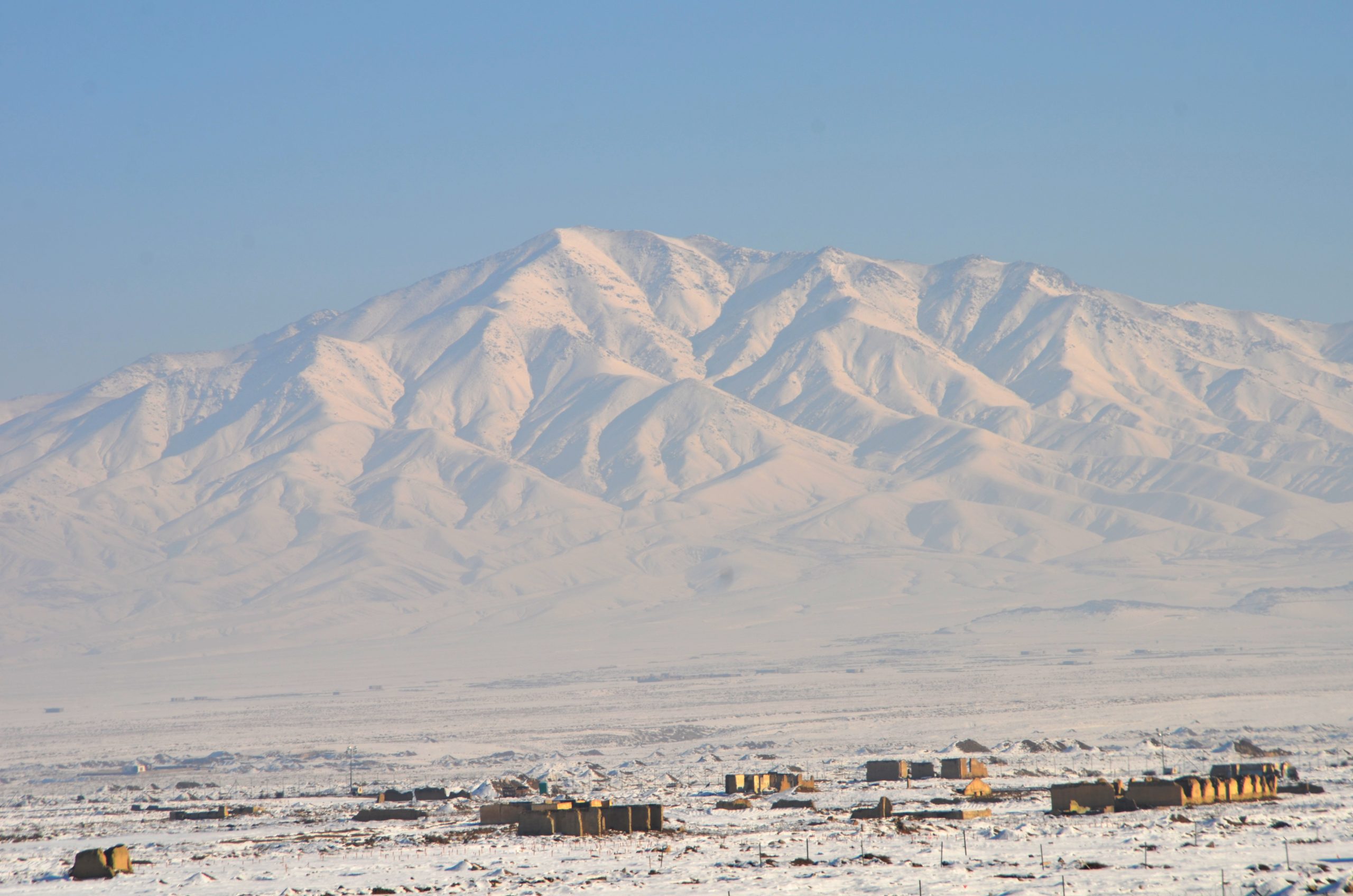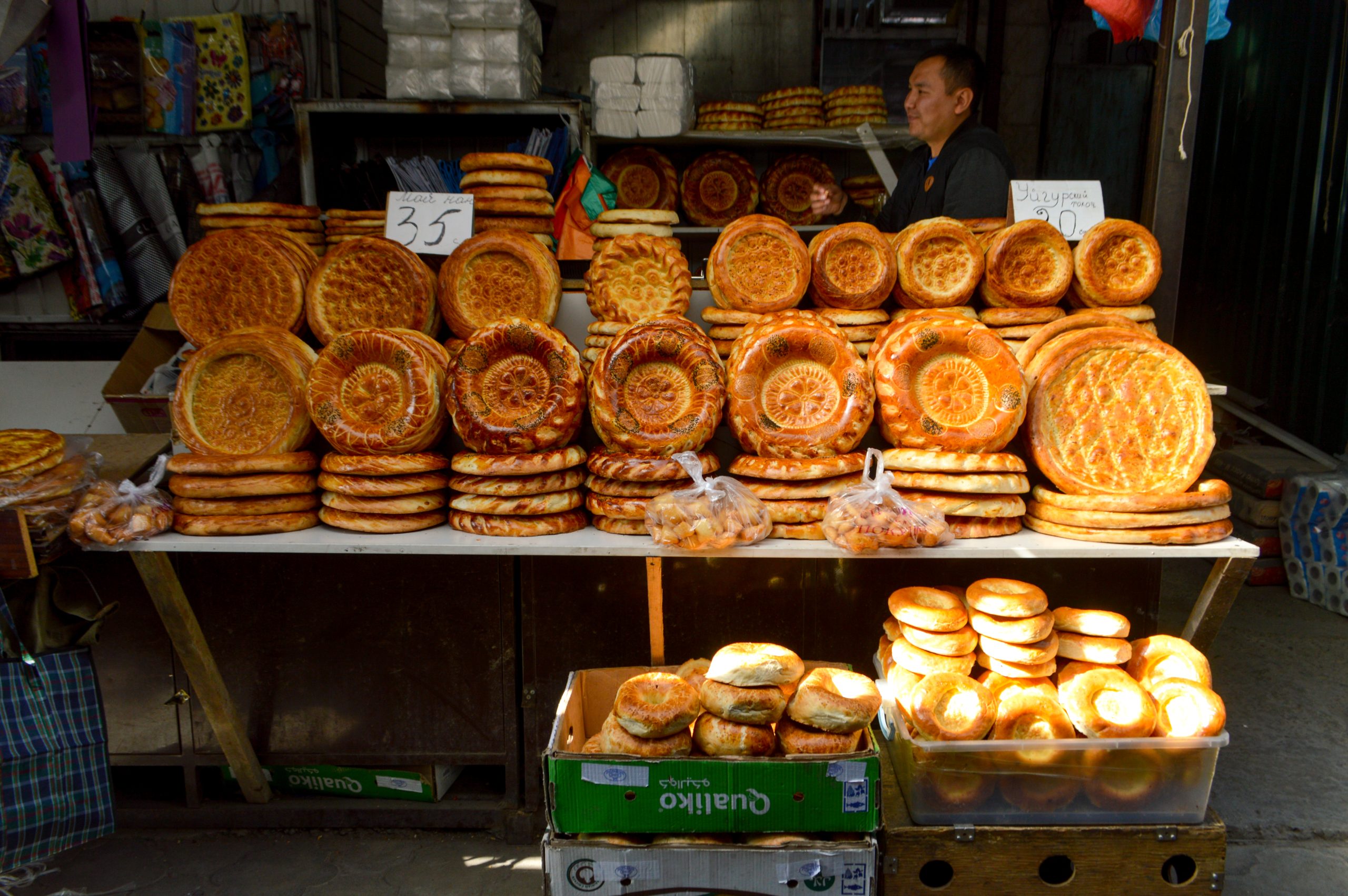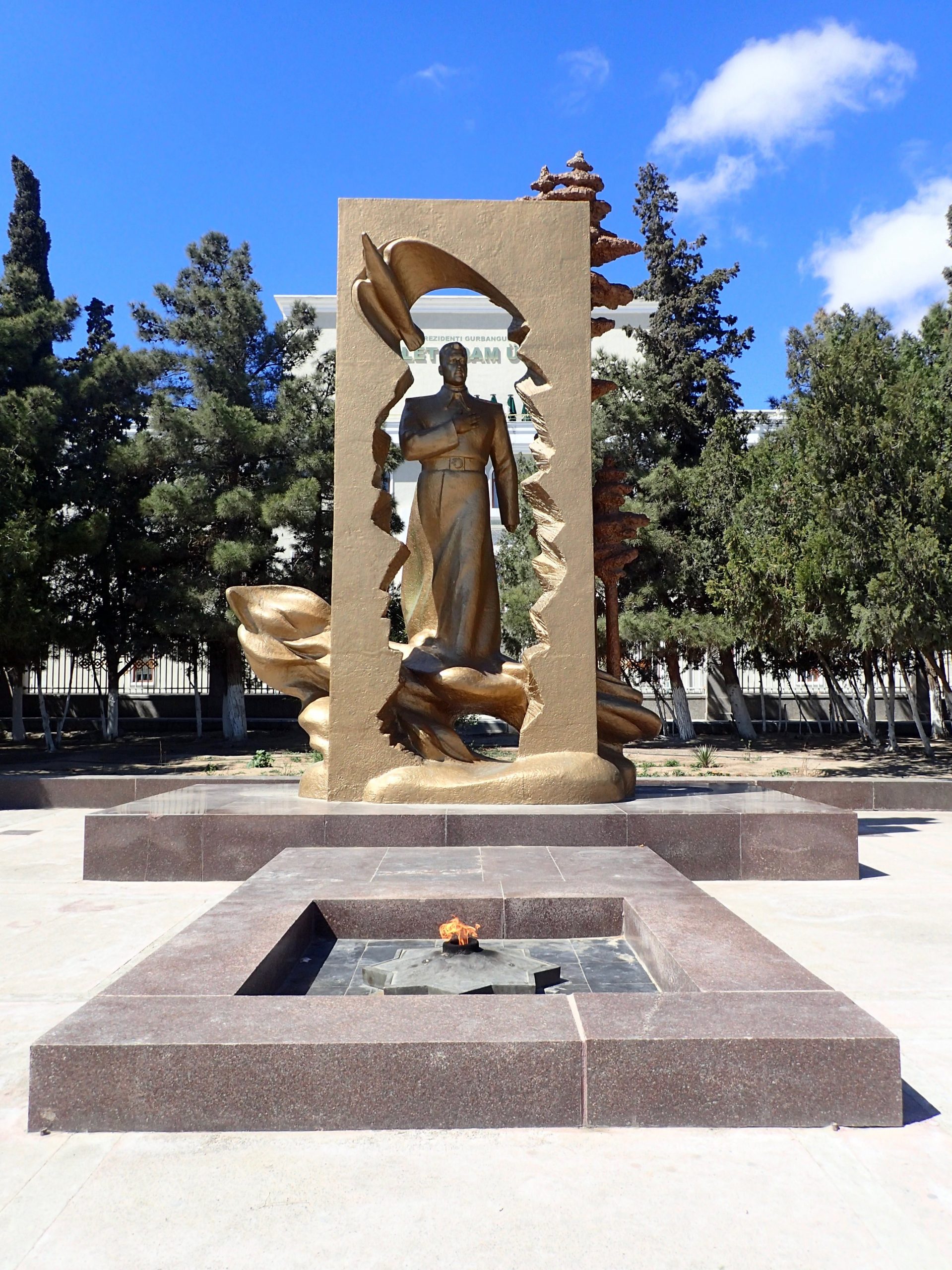90 Central Asia: Overview
Physical Geography
Landforms
The former Soviet republics of Central Asia occupy a vast, flat region bounded on the south and east by high mountains. Turkmenistan, Uzbekistan, and Kazakhstan are mainly flat, while Tajikistan and Kyrgyzstan are quite mountainous, their landscapes dominated by the Pamir and Tien Shan mountains. Azerbaijan is mainly flat, except for the Caucasus Mountains in the country’s south. Much of the region features interior drainage, where rivers ultimately flow to salty interior seas, rather than to the ocean.

The Hindu Kush mountains account for about half of the land area of Afghanistan, running from northeast to southeast across the middle of the country. The southern part of the country is occupied by a hilly plateau, while the north is home to small area of lowlands.
Mongolia is hilly to mountainous in the west and north, and the country’s highest elevations are found in the Altay Mountains of the southwest. Mongolia is generally flat in the east and south.
Climate
Much of Central Asia features arid or semi-arid climates due to the region’s isolation from the world’s oceans. Located at a latitude similar to that of the central United States, much of the region features hot summers and cold winters. Afghanistan, Azerbaijan, Turkmenistan, Uzbekistan, and Kazakhstan are a mixture of mid-latitude deserts and steppe climates. Tajikistan and Kyrgyzstan are a mixture of extremely complex alpine climates bounded by deserts to the north. Mongolia is primarily a semi-arid steppe climate bounded on the south by the Gobi Desert.
Historical Geography
Much of Central Asia’s early history was shaped by its position along major trade routes connecting India and China with the Mediterranean. Because of its strategic position, numerous outside groups have sought to control this region. The Greeks, Arabs, Mongols, Turks, Chinese, Persians, and British have all left a cultural imprint on the region. In the 1800s, a good deal Central Asia fell under Russian control.
Afghanistan, in particular, has had a long history of struggle with outside forces, including the last three great global superpowers. In the 1800s, the British fought two costly wars to take control of the area. The modern borders of Afghanistan were drawn at this time, and the country became a British protectorate, designed to serve as a buffer between British India and Russian Central Asia. After a rebellion in 1919, Britain gave up on its attempt to control Afghanistan. In the late twentieth and early twenty-first centuries, the Cold War superpowers, the Soviet Union and, later, the United States made separate attempts to unify, subdue, modernize, and pacify the country. Neither was successful, as is discussed in Chapter 86.
Mongolia’s history is one of empire. In the 1200s, the Mongols began to forge the largest continuous land empire in world history. At its height, it included all of modern China, Korea, Central Asia, Iran, Iraq, and most of modern Russia. From the 1300s to the 1600s, Mongol Empire began to fragment and decay, eventually dwindling to the area of present-day Mongolia. From the 1600s to the 1800s, most of modern Mongolia was absorbed into the imperial China. With the collapse of the Qing Dynasty in 1911, Mongolia declared independence, and quickly aligned with Russia as protection from future Chinese encroachment. After the Bolshevik Revolution, Mongolia adopted a communist economy, and was a satellite state of the Soviet Union throughout the Cold War. Like the Soviet satellites in eastern Europe, Mongolia broke from Soviet control and abandoned communism in 1990.
Cultural Geography

Photo by Francisco Anzola on Flickr.
The Uzbeks, Kazakhs, Kyrgyz, Turkmen, and Azerbaijanis are primarily Muslim, and speak closely-related Turkic languages. The Tajiks are Muslims with close cultural connections to Iran. All six of these post-Soviet Central Asian countries are nation-states, dominated by the national group for which they are named, but all of them contain significant ethnic minorities. Many of these minorities are members of other Central Asian ethnic groups (for example, there are many Kazakhs in Uzbekistan, and many Uzbeks in Kazakhstan). Many of these countries also contain a number of minorities from European cultural groups, primarily Russian and Ukrainian, a legacy of their time spent as part of the Russian Empire and Soviet Union.
Mongolia is also a nation-state, with Mongols making up 95% of the country’s population. Buddhism is the predominant religion in Mongolia, a unique trait in an otherwise largely Muslim region.
Afghanistan is overwhelmingly Muslim, but with tremendous ethno-linguistic diversity. The Pashtuns, who account for 42% of the country’s population, are the largest ethnic group. Other significant ethnic groups include the Tajiks (27%), Hazaras (9%), and Uzbeks (9%), but there are many other small ethnic groups. More than seventy languages are spoken in Afghanistan.
Population Geography
Wedged in between Europe, South Asia, and East Asia – the world’s three most densely populated regions – Central Asia is, by comparison, very sparsely populated. All of Central Asia’s countries have a population smaller than that of California. Below is a table showing the approximate population of each country in the region, as well as a U.S. state with a comparable population.
| Country | Approximate Population | Comparable U.S. State |
|---|---|---|
| Afghanistan | 30 million | Texas |
| Uzbekistan | 30 million | Texas |
| Kazakhstan | 16 million | Illinois |
| Azerbaijan | 10 million | Michigan |
| Tajikistan | 8 million | Virginia |
| Kyrgyzstan | 6 million | Missouri |
| Turkmenistan | 5 million | Colorado |
| Mongolia | 3 million | Iowa |
Total fertility rates (TFRs) have fallen substantially throughout most of Central Asia in recent decades. The majority of the countries are at or below the world average (2.4), but just above replacement rate (2.1). The one major exception of is Afghanistan, which has a TFR of 5.6, one of the world’s highest. Much of this can be explained by the demographic transition. Afghanistan is poor, rural, and agrarian. It features low rates of education and few career opportunities for women. All of these characteristics lend themselves to high birth rates. Another explanation is the interethnic conflict that has plagued Afghanistan for much of its recent history. In most cases, wars cause birth rates to drop – the United States during World War II is one prominent example. However, in countries where conflict is endemic – that is, where it lasts for multiple generations – birth rates often remain high. If two groups are locked in a seemingly endless conflict, they certainly don’t want their adversary to out-reproduce them, or their children will face worse odds as the conflict is passed on to that generation.
Central Asia is more rural than many world regions. Only Mongolia (62% urban), Kazakhstan (59%), Azerbaijan (55%), and Turkmenistan (50%) consist of populations that are at least half-urbanized. Central Asia’s other countries are predominantly rural, including Uzbekistan (36% urban), Kyrgyzstan (35%), Tajikistan (26%), and Afghanistan (23%). That said, most of Central Asia’s countries are urbanizing fairly rapidly. The notable exception is Afghanistan, which shows few signs of becoming significantly more urban in the near future.
Political Geography
Mongolia is Central Asia’s lone beacon of democracy, having conducted free, multi-party elections since 1990. Afghanistan was somewhat democratic from 2004 to 2021, holding a number of multi-party elections during that period. Still, those elections were marred by accusations of fraud, and many Afghans refused to recognize the legitimacy of the central government. Afghanistan’s experiment in democracy came to an end in 2021 when the Taliban regained control of the country (see Chapter 85).
None of the post-Soviet states in Central Asia is a democracy. In these countries, presidents frequently rule until their deaths, or until they are forced from power in an armed rebellion. Although all these countries are nominal democracies, and frequently hold elections, most of the elections are blatantly fraudulent. The post-Soviet states have essentially carried on the Soviet-era tradition of political strongmen.
Azerbaijan has had only four presidents since 1990. Dissent in the country is not tolerated, and human rights abuses are common. Kazakhstan has had only two presidents since 1990. It has never conducted a free, multi-party election. Its government also suppresses dissent, and has also been accused of numerous human rights violations. Kyrgyzstan has had six presidents since 1990, and fraudulent elections, corruption, and the repression of political opponents are common. Tajikistan has had only three presidents since 1990 (and only one since 1994). From 1992 to 1997, 100,000 Tajiks were killed in an unsuccessful Islamist uprising.

Turkmenistan was ruled by Saparmurat Niyazov from 1990 until his death in 2006. Niyazov was declared president for life in 1999 by the Turkmen parliament, which he had hand-picked. Niyazov’s oppressive regime featured a truly bizarre cult of personality. He adopted the name “Turkmenbashi” (meaning “Head of the Turkmen”), renamed the months on the Turkmen calendar (January after himself and April after his mother), and made his autobiography mandatory reading in all schools. Turkmenistan has had only two additional presidents since 2006 – Gurbanguly Berdimuhamedow, who ruled for fifteen years, and his son, Serdar, who was “elected” in 2022. Turkmenistan has yet to hold a truly free election, and corruption and political repression are commonplace.
Uzbekistan has had only two presidents since 1990. It has never held a free election, and its human rights record is often compared to that of North Korea. Peaceful human rights protestors have gunned down in the streets, and political prisoners have been boiled alive. One American ambassador described Uzbekistan as “a nightmarish world of rampant corruption, organized crime, forced labor, and torture.”
Economic Geography
Central Asia is a relatively poor region. Kazakhstan has the region’s highest overall standard of living, which is near the world average. The rest of Central Asia’s countries have standards of living that are below the world average. Afghanistan is, by ever measure, the poorest country in the region, and one of the poorest in Asia.
Most of Afghanistan’s population is engaged in ranching, nomadic herding, or irrigated crop farming. Afghanistan has significant economic potential due to its impressive reserves of natural gas, oil, coal, copper, and iron, but its constant state of political unrest, coupled with international sanctions placed on the Taliban regime, make any immediate economic gains from these resources unlikely.
Mongolia’s rural economy has long been dominated by animal herding – most of the country is too dry for crop farming. The country also possesses some copper reserves, and has seen steady growth in textile manufacturing, but remains largely poor.
The economy of the post-Soviet republics is dominated by agriculture and mining. Traditionally a region of nomadic herders, many of the region’s pastoralists were forcibly settled into collectives during the Soviet era. Most of the region’s crops are grown at the base of the southern mountains, where irrigation water is plentiful. Cotton is the leading crop, and is the primary source of export earnings for Uzbekistan. Kazakhstan’s wealth is largely derived from mining. It control’s 70% of the Caspian Sea’s considerable oil and natural gas reserves, and possesses a number of other minerals, such as coal and iron ore. Azerbaijan and Turkmenistan possess smaller, but still significant, oil and natural gas fields. Most of Kyrgyzstan’s export revenue is derived from gold mining, and much of Tajikistan’s revenue comes from bauxite exports.
Did you know?
My Turn!
CITED AND ADDITIONAL BIBLIOGRAPHY:
Anzola, Francisco. Kyrgyz Bread. Photo, 14 Oct. 2019. Flickr, https://www.flickr.com/photos/fran001/48897869443/. Attribution 2.0 Generic (CC BY 2.0).
Kaesong, Hotel. Türkmenbashi. Photo, 4 Apr. 2017. Flickr, https://www.flickr.com/photos/laika_ac/35810584461/. Attribution-ShareAlike 2.0 Generic (CC BY-SA 2.0).

